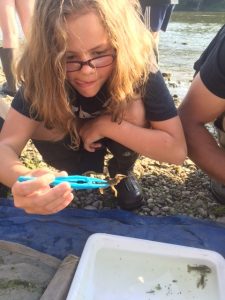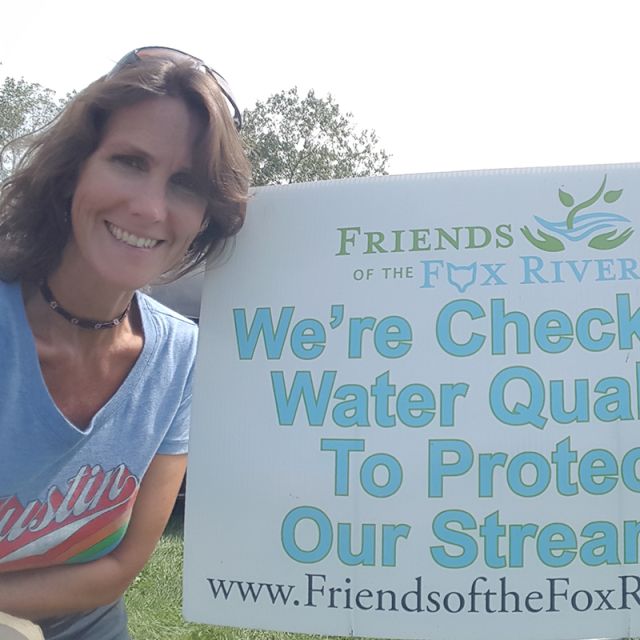by Gary Swick
Having access to clean water is a need for all living things. The natural environment provides that through the hydrological cycle. Humans  routinely interrupt that process and threaten their own water quality. It is the mission of Friends of the Fox River to protect our watershed through education, restoration, research, and advocacy.
routinely interrupt that process and threaten their own water quality. It is the mission of Friends of the Fox River to protect our watershed through education, restoration, research, and advocacy.
I know two things that effectively protect water quality: legislation and people. Scientists should guide this legislation. We are now entering the season where our educators are leading students into their local streams through our Watershed Watchdog program. Students are the citizen scientists here.
Friends of the Fox River has empowered citizens and students to collect data in their local streams to monitor their health. To achieve this goal 126 stream monitoring sites have been established and empower citizen scientists to advise decision makes on the health trends and identify protection needs. The main indicators of habitat health/water quality are the little critters like dragonfly larvae and crawfish that call these streams home. The experience is intended to provide a long-term view but also to act as first responders when incidents occur.
Dirty Water, Bright Students & Smart Action
Our first significant impact of the “Data for Decisions” concept dates back almost thirty years. High school students were at Crystal Creek at Towne Park in Algonquin which usually rates as “very good” stream on a biological diversity index. However, on that spring day, it rated as “poor.” The usual ten species found there was down to only one. The water was murky brown (not crystal clear) and the rock bottom was  covered in slimy sediment. The students were surprised and concerned as they felt “their” stream had been violated. The habitat was damaged and the organisms relying on it were decimated. Upon further investigation, it was found that a construction project at Hansen Hill had exposed the soil on a large area with a steep slope above Crystal Creek which was directly affecting the health of the creek.
covered in slimy sediment. The students were surprised and concerned as they felt “their” stream had been violated. The habitat was damaged and the organisms relying on it were decimated. Upon further investigation, it was found that a construction project at Hansen Hill had exposed the soil on a large area with a steep slope above Crystal Creek which was directly affecting the health of the creek.
The students decided to take action and collected a sample of the creek water in a quart jar and brought it to a Village of Algonquin trustee meeting. When they displayed the jar to the trustees it appeared clear. The students explained how they had been monitoring the health of Crystal Creek by collecting and identifying the diversity of aquatic life that it supported and evaluating the physical habitat. The sample jar was full of clear water with a small layer of sediment discreetly resting on the bottom. After agitating the jar, the contents became murky brown. The students explained how the sediment covered the rock substrate which is necessary habitat for the organisms and that the sediment also has other related impacts including reducing necessary oxygen. The source of the sediment was identified and a request for action was delivered. The trustees were concerned and felt they needed to take action to protect Crystal Creek.
Shortly thereafter, the Village of Algonquin enacted a construction site erosion ordinance. People and legislation do indeed protect water quality.
Creating a Watershed of Caretakers
In 2009, Friends of the Fox River began providing outreach education to schools in the watershed. From Waukesha, Wisconsin to Yorkville, Illinois students have joined us in collecting biological, physical, and chemical data. It is important to identify local events like the one in Algonquin, but also to monitor watershed trends. More important is the development of a student’s stewardship ethic. That comes from a relationship with their stream. They first learn how precious the life is in their stream, then they connect the habitat requirements to support that life. With the guidance of educators they can understand the threats, and actions available to reduce those threats on an individual and community level. This is how we work toward our goal of “Creating a Watershed of Caretakers.”
 Throughout April and May, our educators will be guiding students in biological, physical, and chemical data collection in their streams. The biological indicators are the little critters that inhabit the stream like crayfish and dragonfly larva that have measurable varying tolerances to pollution. The physical parameters that make up habitat like substrate composition, shade, and stream velocity contribute to organism success. The chemical compositions are the limiting factors. Together with the students, our educators analyze the data, and consider appropriate actions.
Throughout April and May, our educators will be guiding students in biological, physical, and chemical data collection in their streams. The biological indicators are the little critters that inhabit the stream like crayfish and dragonfly larva that have measurable varying tolerances to pollution. The physical parameters that make up habitat like substrate composition, shade, and stream velocity contribute to organism success. The chemical compositions are the limiting factors. Together with the students, our educators analyze the data, and consider appropriate actions.
The Watershed Watchdogs provide an important function in the watershed’s protection with their monitoring efforts. Since the professionals from the Illinois Department of Natural Resources are only able to monitor our watershed once every five years this is very important work. Friends of the Fox River is expanding our school service and rejuvenating our citizen involvement. If you are interested as an individual, organization, or have a school affiliation, please contact us to get involved.
Two things protect our Fox River: legislation and people. Please join us in that effort. Let’s Keep on Fixin’ the Fox.


